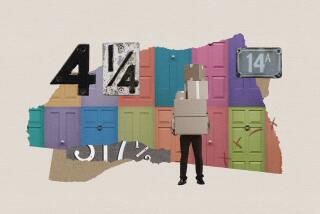Post Office Math <i> Does</i> Make Sense--to Them : Why a hike to 32 cents when 35 would have been easier to figure? For starters, there’s this law . . .
- Share via
The nation once again will be plunged into a state of chaos on Sunday as the price of a first-class stamp goes from 29 cents to 32 cents.
But it’s not the rate hike, per se, that’s irritating many consumers.
“A few cents more won’t matter,” shrugged Jean Anne Brown philosophically as she looked through her mail at Glendale’s main post office last week.
What’s annoying and confusing will be the need to deal with new numbers, new multiples, new bottom lines. Yes, just when we knew by heart that a book of 20 29ers was $5.80, along comes a whole new set of computations for those among us who didn’t exactly excel in Math 101.
And why, oh, why did they pick something hard to calculate like 32?
“If they’re going to raise it, why not raise it to 35 cents and forget it for 10 years?” asked Nick Johnston while pumping coins into a self-service stamp machine at the downtown Burbank post office.
A 35-cent postage stamp also makes sense to Larry Russell, another patron. “I think they should level off the price,” he said. “It’d be easier, change-wise.”
Solomon Golomb doesn’t understand why there’s math anxiety.
“Thirty-two is a much rounder number than 29,” said the USC professor of mathematics and electrical engineering. “It’s more divisible by more things.”
Getting into the swing at the stamp counter won’t be hard, he insisted. “Five 32s would be $1.60,” Golomb said during a phone interview, with nary a background sound of a calculator or adding machine. “Twenty-five would be eight dollars.”
Uh-huh. But here’s a man who, just for a lark, once memorized the first 1,000 digits of pi--the two- vertical- lines- with- a- squiggle- on- top symbol that represents the ratio of the circumference of a circle to its diameter. No big deal, at least for him. “Several million digits of pi have been calculated,” he added modestly.
*
Did the postal powers-that-be take into account that some of us still count on our fingers and rely on very round numbers when buying anything from postage stamps to rutabagas in bulk?
Of course, said Charles Robinson, a senior analyst at the U.S. Postal Rate Commission, an independent government agency that considers rate hike requests from the U.S. Postal Service and issues recommendations.
“By law, we have to think about simplicity of the rate structure,” said Robinson, referring to the 1970 Postal Reorganization Act. But in the next breath, he explained the odd-number odysseys: “By law, revenues have to equal expenses,” he said.
To consumers, it might seem simple to bypass a 32-cent stamp in favor of a 35-cent one. But that increase, said Robert Cohen, director of rates, analysis and planning for the commission, would wreak havoc on the break-even mandate. “It would mean $2.7 billion in extra revenues for first class and require lowering rates for the rest of the classes,” he said, “which would be inequitable.”
Math-phobic postal patrons may be overreacting, Robinson said, pointing out that there have been some nice round prices for first-class stamps--15 cents in 1978, 20 cents in 1981 and 25 cents in 1988.
Robinson thinks the tougher math problems will plague businesses who use other rates.
Second-class mail, which includes magazines and newspapers, is considered the most complex because it involves such things as piece rates, pound rates, zoning and advertising- to- editorial ratio, the postal people say.
“From 29 to 32, that’s simple,” said Robinson, who is sad to see the demise of 29-cent stamps, in use since 1991, for an entirely different reason. “I like 29 because it’s a prime number,” he said wistfully.
*
If mathematicians and analysts think we’re overreacting, mental health experts sympathize. It’s not abnormal, they say, to have a bit of angst .
“Nice round numbers are easier,” says Paul Andreassen, a social psychologist in Deerfield Beach, Fla. “It represents a need for control--not in a manipulative sense, but in terms of having a sense of mastery over the environment.”
Coping with the postal rate hike, in his view, can be a stressor. “Any time you take something small and make it more difficult it becomes an irritation and little irritations add up. People are more prone to get sick when they have (many) small hassles in their life.”
When it’s not so simple to do the math in your head, the stress can worsen. It makes sense to him that postal patrons are suggesting a 35-cent stamp--”35 cents seems easier to figure than 32.”
Postal patrons who aren’t very good at math “should just memorize some stamp multiples,” Andreassen suggested. “Two are 64 and three are about a dollar.
“By the time people are regularly writing 1995 on their checks,” Andreassen said, they’ll also be accustomed to new stamp prices.
Unless, of course, they are the rebellious type, like David Londagin.
“I’m going to use fax,” the 70-year-old Pasadena businessman said stubbornly during what may have been his last trip to the Glendale post office.
(BEGIN TEXT OF INFOBOX / INFOGRAPHIC)
A Guide for Mathematically Challenged
Here’s a guide for the mathematically challenged to the new first-class stamp rates, effective Sunday:
1: 32 cents 2: 64 cents 3: 96 cents 4: $1.28 5: $1.60 6: $1.92 7: $2.24 8: $2.56 9: $2.88 10: $3.20 11: $3.52 12: $3.84 13: $4.16 14: $4.48 15: $4.80 16: $5.12 17: $5.44 18: $5.76 19: $6.08 20: $6.40 Source: a calculator

